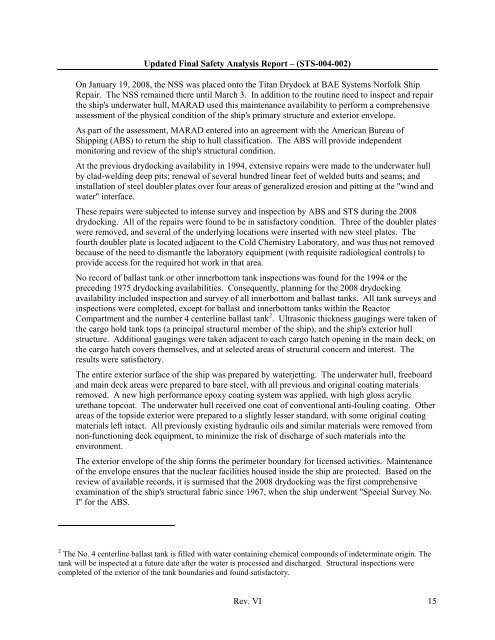10 CFR 50.71(e) - Maritime Administration - U.S. Department of ...
10 CFR 50.71(e) - Maritime Administration - U.S. Department of ...
10 CFR 50.71(e) - Maritime Administration - U.S. Department of ...
Create successful ePaper yourself
Turn your PDF publications into a flip-book with our unique Google optimized e-Paper software.
U p da te d Fi na lS af et yA n al ys is Re po rt (S T S- 0 x)Updated Final Safety Analysis Report – (STS-004-002)On January 19, 2008, the NSS was placed onto the Titan Drydock at BAE Systems Norfolk ShipRepair. The NSS remained there until March 3. In addition to the routine need to inspect and repairthe ship's underwater hull, MARAD used this maintenance availability to perform a comprehensiveassessment <strong>of</strong> the physical condition <strong>of</strong> the ship's primary structure and exterior envelope.As part <strong>of</strong> the assessment, MARAD entered into an agreement with the American Bureau <strong>of</strong>Shipping (ABS) to return the ship to hull classification. The ABS will provide independentmonitoring and review <strong>of</strong> the ship's structural condition.At the previous drydocking availability in 1994, extensive repairs were made to the underwater hullby clad-welding deep pits; renewal <strong>of</strong> several hundred linear feet <strong>of</strong> welded butts and seams; andinstallation <strong>of</strong> steel doubler plates over four areas <strong>of</strong> generalized erosion and pitting at the "wind andwater" interface.These repairs were subjected to intense survey and inspection by ABS and STS during the 2008drydocking. All <strong>of</strong> the repairs were found to be in satisfactory condition. Three <strong>of</strong> the doubler plateswere removed, and several <strong>of</strong> the underlying locations were inserted with new steel plates. Thefourth doubler plate is located adjacent to the Cold Chemistry Laboratory, and was thus not removedbecause <strong>of</strong> the need to dismantle the laboratory equipment (with requisite radiological controls) toprovide access for the required hot work in that area.No record <strong>of</strong> ballast tank or other innerbottom tank inspections was found for the 1994 or thepreceding 1975 drydocking availabilities. Consequently, planning for the 2008 drydockingavailability included inspection and survey <strong>of</strong> all innerbottom and ballast tanks. All tank surveys andinspections were completed, except for ballast and innerbottom tanks within the ReactorCompartment and the number 4 centerline ballast tank 2 . Ultrasonic thickness gaugings were taken <strong>of</strong>the cargo hold tank tops (a principal structural member <strong>of</strong> the ship), and the ship's exterior hullstructure. Additional gaugings were taken adjacent to each cargo hatch opening in the main deck; onthe cargo hatch covers themselves, and at selected areas <strong>of</strong> structural concern and interest. Theresults were satisfactory.The entire exterior surface <strong>of</strong> the ship was prepared by waterjetting. The underwater hull, freeboardand main deck areas were prepared to bare steel, with all previous and original coating materialsremoved. A new high performance epoxy coating system was applied, with high gloss acrylicurethane topcoat. The underwater hull received one coat <strong>of</strong> conventional anti-fouling coating. Otherareas <strong>of</strong> the topside exterior were prepared to a slightly lesser standard, with some original coatingmaterials left intact. All previously existing hydraulic oils and similar materials were removed fromnon-functioning deck equipment, to minimize the risk <strong>of</strong> discharge <strong>of</strong> such materials into theenvironment.The exterior envelope <strong>of</strong> the ship forms the perimeter boundary for licensed activities. Maintenance<strong>of</strong> the envelope ensures that the nuclear facilities housed inside the ship are protected. Based on thereview <strong>of</strong> available records, it is surmised that the 2008 drydocking was the first comprehensiveexamination <strong>of</strong> the ship's structural fabric since 1967, when the ship underwent "Special Survey No.I" for the ABS.2 The No. 4 centerline ballast tank is filled with water containing chemical compounds <strong>of</strong> indeterminate origin. Thetank will be inspected at a future date after the water is processed and discharged. Structural inspections werecompleted <strong>of</strong> the exterior <strong>of</strong> the tank boundaries and found satisfactory.Rev. VI 15
















